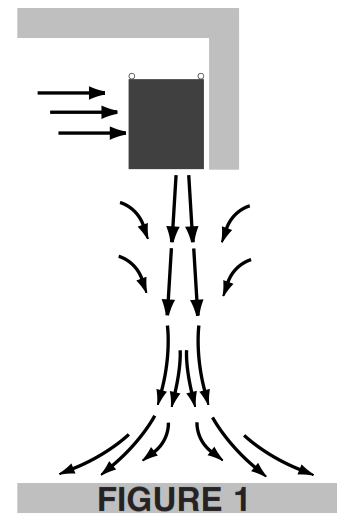Your shopping cart is currently empty.
Air Curtains
Industrial and Commercial Grade Air Curtains
 |
 |
| Air Curtains are
used for a wide variety of applications from thermal barriers at
shopping mall entrances, to fly and insect prevention at restaurant
service doors, to factory freight doors for wind resistance and
temperature separation. The air curtain enables traffic to flow
unobstructed through openings while maintaining distinct environments,
thus resulting in energy savings. The most common type of air curtain is
the horizontal, non- recirculating, single jet type. It will satisfy
the majority of needs for commercial and industrial applications. The
discharge velocity of the air curtain can range from 600 ft/min, for
entrance ways, to over 5,000 ft/min, for sealing environments from wind
effects and insects. How Air Curtains Work: Air curtains consist of a fan and nozzle system which create a jet of high velocity air directed across a door opening, providing a protective air shield. The air shield minimizes the transfer of heat, moisture, dust, fumes and insects through the doorway. |
 |
Air curtains as illustrated in Figure 1 pull in air and accelerate it through the fan and nozzle system, thus creating a moving wall of air across the opening or doorway. The air curtain fan adds kinetic energy to the air, providing the resistance to the penetration of unwanted air or particles. This added kinetic energy in the discharge air also resists the penetration of outside air due to the wind, as well as the invasion of insects. The air is provided at a critical velocity and volume flow as well as at a discharge angle selected for its particular application. Applications are: Thermal Barriers for conditioned space isolation; Wind Resistance for protecting exterior doorways in buildings from unconditioned air; Interior Separation for particle and dust control; and Fly and Insect Control for sanitation maintenance. Each application is discussed in more detail in the following pages. |
| Thermal Barriers: When
dividing spaces with temperature differences, the air curtain prevents
the natural flow of air caused by differing temperatures. The difference
between indoor and outdoor temperature creates an imbalance in density,
and therefore a pressure variation which causes the infiltration of
outside air. The installation of a properly-designed air curtain at the
top of the doorway provides a shield of high velocity air that deflects
the natural convection air flow. This significantly reduces the exchange of air and energy between warm and cold sides, resulting in monetary savings. Fly and Insect Control: Sanitation maintenance applications require that the air curtain prevents the entry of airborne insects. For fly and insect control the air curtain projects the high velocity jet across the opening, thus deflecting and prohibiting the entrance of unsanitary insects. National Sanitation Foundation (NSF) Standard 37 requires that service entry units shall develop an air stream that is at least 3 inches thick with a minimum air velocity of 1600 ft/min, across the entire entryway measured at 3 feet, above the floor. Proper design, selection and installation of an air curtain will allow this standard to be met, maintaining sanitary conditions. Interior Separation (Separating Environments). In many facilities there often exist manufacturing or production areas adjacent to either offices or other clean environments. The production side may generate fumes, dust and heat which are undesirable in the adjacent areas. Air Curtains are ideally suitable for these applications, repelling the undesirables without restricting traffic. The air curtain is mounted on the cleans side so as not to circulate the contaminants through the unit, as well as to prevent blowing the contaminants into the clean side. |
Sort By:
Items per page:
Page 1 of 6:
Price:
$566.00
Price:
$744.00
Price:
$762.00
Price:
$972.00
Price:
$722.61
Price:
$1,110.00
Price:
$1,131.00
Price:
$994.00
Price:
$1,138.00
Sort By:
Items per page:
Page 1 of 6:





